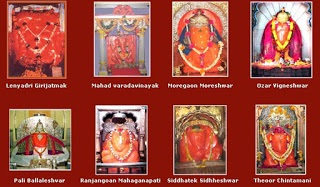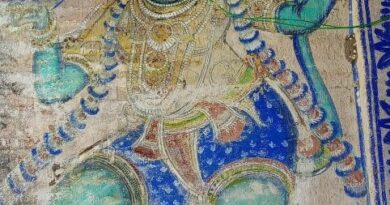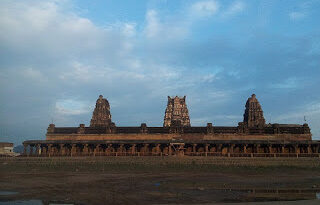Ashta vinayak Temples ( 8 temples of Ganesh) – Maharashtra
Ashta vinayak Temples – Maharashtra
The Ashta vinayak temples of Maharashtra refer to the Eight pilgrimage shrine of Shree Ganesh. Ashta=Eight and Vinayak is also another name for Ganpati. These eight pilgrimage shrines are located in various places in Maharashtra, especially around Pune. Out of 8, six temples are located in Pune and the other two in Raigad district.
Main Deity – Ganpati or Vinayaka is considered the lord of Wisdom and knowledge. Ganpati is “pratham aradhya” or the first to be worshipped, before a Puja or yagya can take place. Ganesh Chaturthi is celebrated all over Maharashtra with great fervor. The Lord is believed to be a protector. Devotees believe that everyone should visit Ashtavinayak once during their lifetime.
Temple Specialties – Each idol in these eight temples is “Swayambhu” or self manifested. Interestingly, even though these are not huge idols, every idol is in a different form in each temple. Especially the trunks are distinct. Ganpati is known by eight different names in each of these temples. The names are – Moreshwar, Mahaganpati, Chintamani, Girijatmak, Vighneshwar, Siddhivinayak, Ballaleshwar and Varad Vinayak. The temples are located in These Temples are situated at Morgaon, Ranjhangaon, Theur, Lenyadri, Ojhar, Siddhatek, Pali(Raigad District) and Mahad (Raigad district). Legends say, that in order to complete the Ashtavinayak Yatra (tour of all eight temples), one must visit the temples in a particular order. This order is as follows –
1. Moregaon
2. Siddhatek
3. Pali
4. Mahad
5. Theur
6. Lenyandri
7. Ozar
8. Ranjhangaon
9. And Again Moreshwar – It is believed that one must visit the first ganpati after completing the visits to all eight; to end the yatra.
Let us look into all 8 temples in detail –
1. Shri Mayureshwar/Moreshwar; Morgaon – This temple is located around 60 km from Pune as is the first temple to be visited during the yatra. This temple gets its name from the bird, peacock. In marathi Mor=peacock and gaon=village. According to the legends, the demon Sindhu was terrorizing the Gods. At their behest, Ganpati slayed the demon while riding on a peacock. Hence the name.
It is situated on the banks of river Karha. The idol here has three eyes and the trunk is towards the left. It is believed that a left curved trunk brings success. The deity here is seen with his consorts Riddhi (intelligence) and Siddhi (capability) This temple was carved during the reign of the Bahamanis and has evidences of Mughal architecture.
2. Shri Siddhivinayak, Siddhatek – This temple is located in the Ahmadnagar district, about 100 kilometers from Pune off the Pune-Solapur highway. This temple was built during the Peshwa regime .The main sanctum was built by queen of Indore, Maharani Ahilyabai Holkar. This village is located along the banks of river Bheema.
According to the legends, lord Vishnu gained Siddhi (capability) to destroy the demons Madhu and Kaitab on the mountains of Siddhatek after praying to Shri Ganpati. The idol here has his trunk towards the right. It is the only temple among the 8 to do so. This is considered a sign of power. There are also shrines for Lord Shiva and goddess Shivai in this temple.
3. Shri Ballaleshwar, Pali – Pali village is situated in Raigad district. The temple here is built between fort Sarasgad and river Amba. This temple was built during the Peshwa regime.
It is said that there was once a young lad named Ballal, who worsipped Shri Ganesh with all his heart. He worshiped a stone as Ganpati’s form. Ganpati is said to have come to his aid dressed as a Brahmin, hence the stone idol in this temple is still dressed in Brahmin clothes. This is the only temple of the lord, where Ganpati is know by his devotees name.
The main attraction of this temple is that during sunrise, the suns rays fall directly on the idol and illuminated the bejeweled eyes of the idol.
4. Shri Varadvinayak, Mahad – Mahad is a village near Khopoli in the Raigad district of Maharashtra. In Marathi VaradVinayak means – lord who fulfils wishes or boons. The idol that is present in this temple was found immersed in a lake in 1690 AD. This temple is constructed by Subhedar Ramji Mahadev in 1725 AD. The main attraction of this temple, is an oil lamp called the nandadeep, which is said to be kept burning since 1892.
The idol here, has a weathered look and the temple too is pretty humble looking. However, this is the only Ashtavinayak temple where one can personally go near the lord and offer prayers. At two corners of the sanctum, two Ganesha idols can be seen. One is the original Varad Vinayak idol with the trunk turned towards left and the other a marble idol with its trunk towards the right.
5. Shri Chintamani, Theur – The village of Theur is about 25 km from Pune. This temple is situated near the junction of the three rivers Mula, Muth and Bhima in Pune district. This temple was built by Madhavrao Peshwa.
Legends say that Sage Kapila, had a prescious jewel named Chintamani that was stolen from him by a greedy prince named Guna. Ganpati later got the jewel back for the sage. Kapila then put the jewel around Ganpati’s neck and hence he is known as Chintamani. Another story says, lord Brahma was once feeling very restless. He then called upon Shri Ganesh to ease his mind. In Marathi Chinta means “worry” and Chintamani is said to reduce stress and bring peace of mind to his devotees.
The main hall of the temple has a water fountain made of black stone. Besides Ganpati there are also shrines for Shiva, Vishnu-Lakshmi and Hanuman.
6. Shri Girijatmajavinayak, Lenyadri – This temple is situated around 95 km from Pune, in the Lenyadri mountains. Lenyadri is on the banks of the river Kukadi. From the temple, once can also view the Pashupathi river.
Girijatmaja means, son of Girija. Girija is another name for Goddess Parvati. It is said that in these mountain caves, Parvati undertook a penance to have a son.
The temple is situated amidst other caves. Once has to climb a flight of around 300 steps to reach the temple. The entire temple is carved out of a single stone. The idol is carved on a wall of the cave.
7. Shri Vigneshwar, Ozar – Ozar is located in Narayangaon of the Junnar Taluka. This temple too is along the banks of the river Kukadi which is around 80 km from Pune, off the Pune-nashik highway.
As per legend, a demon named Vighnasur was troubling the sages. Once, Lord ganesha defeated the demon, the demon apologised and asked for mercy. Lord Ganesh benovelently granetd his plea but said that the demon could not go to any place where ganesha is being worshipped. Vghnasur agreed and asked Ganesha to take his name, hence Shri Ganesh here is call Vighneshwar.
In Marathi Vighna means obstacles and Vighneshwar is the destroyer of all obstacles.The temple is enclosed on all sides by high stone walls and the Gopuram is made out of Gold. Th idol faces east and is flanked by Riddhi and Siddhi.
8. Shri Mahaganpati, Ranjhangaon – Ranjhan is a small village situated at a short distance from Pune . This temple was built by Madhavrao Peshwa, and is dedicated to Maha Ganapati (the most powerful form of Ganpati). The Mahaganpati idol has ten trunks and twenty hands.
Temple legend says that to fight the demon tripurasur, Lord Shiva had prayed and invoked Maha Ganpati. Another name for the lord here is Tripurarivade Mahaganpati.
During dakshinayan (southward movement of the sun) the sun rays fall directly on the idol of Mahaganpati. The temple is east facing with big and beautifully carved entrance gates. At these gates, idols of the gatekeepers, Jay and Vijay (who guard Vaikuntha, the sacred abode of Shri Vishnu) are present.
Map – The entire Ashtavinayak yatra is mapped in the following link –
http://www.mapsofindia.com/maps/maharashtra/ashtavinayak-yatra-route.html
How to Reach – Ashtavinayak tours are run by private operators. Besides these, there are special buses that run from Pune and other major cities in Maharashtra.
Planning your stay – Hotels, lodges, dharmashalas or MTDC guest houses are easily available. Most tour operators have details of all the places that visitors can stay in.
Location: Maharashtra, India


